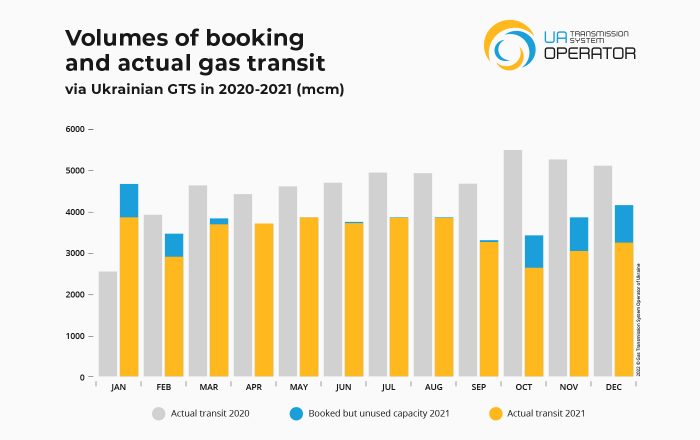In 2021, the Gas TSO of Ukraine transited 41.6 billion cubic meters of natural gas to Europe (-25% compared to 2020). The volume of gas transported from Europe to Ukraine for the same period amounted to almost 2.6 billion cubic meters (six times less compared to 2020). Gas export including re-export amounted to 2.6 billion cubic meters of natural gas.
Natural gas transit
The average daily transit volume in 2021 amounted to 114 million cubic meters of gas per day, but in some periods it decreased to 67 million cubic meters.
In total, 44.4 billion cubic meters of transit capacities at the exit points from Russia were booked in 2021 (40 billion cubic meters, according to the terms of the current transit contract*, 4.4 billion cubic meters were booked at monthly and daily auctions), and only 41.6 billion cubic meters of which were used. Despite a significant increase in prices in European gas markets due to a shortage of natural gas and a reduction in reserves in European UGS facilities, the possibilities of the Ukrainian transit route, that are more than sufficient to overcome the gas crisis in the EU, were not used. On the contrary, during the period of the greatest increase in gas prices in October-December on the European gas markets and the beginning of the autumn-winter period, the average monthly transit of gas from Russia to the EU countries was 17% lower than in January-August.
In the western direction, GTSOU transported 38 billion cubic meters of gas (26% less than in 2020), 4 billion cubic meters of which – to Slovakia (-29%), 3,8 billion cubic meters to Poland (+1%), 6.8 billion cubic meters to Hungary (-29%).
In the southern direction, transit amounted to 3.6 billion cubic meters (-8%), 0.4 billion cubic meters (-56%) of which were to Romania and about 3.2 billion cubic meters (+ 6%) – to Moldova. A significant reduction in transit volumes to Hungary and Romania was also caused by the transition of these countries to bypass gas pipelines of Gazprom. Therefore, from April 1, 2021, physical transit in the Trans-Balkan direction (GDS Orlovka) to Romania was stopped, and from October 1 – to Hungary (GDS Bereg).
“In 2021, the capacity of the Ukrainian GTS was used by less than 30%. This proves once again that the existing transit capacities are sufficient to supply the EU with natural gas in the required volume, and there is no physical or economic need for the construction of new gas pipelines. The reliable and ramified GTS of Ukraine is capable of providing transit of at least another 100 billion cubic meters of gas in the European direction”, – commented Sergiy Makogon, CEO of Gas TSO of Ukraine.
Natural gas transportation from the EU to Ukraine
Natural gas import to Ukraine amounted to 2.6 billion cubic meters, which is six times less than in 2020. The import was carried out mainly by virtual reverse (backhaul), which GTSOU introduced at the beginning of 2020. 89% of gas was imported by virtual reverse.
In total, in January-December, the transportation of gas from the EU to Ukraine was ordered by 50 traders, including 25 Ukrainian companies and 25 foreign ones. And 29 companies used the services of short-haul and “customs warehouse”.
Hungary became the main gas exporter, from which more than 2,2 billion cubic meters of gas was delivered (-47% compared to last year). Despite the stop of physical transit to Hungary from October 1, 2021, the virtual imports remained at the Bereg point: in October-December 2021, Ukraine imported 55.6 million cubic meters from Hungary, and exported – 792 million cubic meters.
Import from Slovakia amounted to 285.3 million cubic meters (-97%), from Poland – 78.6 million cubic meters (-95%).
Last year, GTSOU successfully worked on expanding guaranteed capacities for gas imports to Ukraine. In particular, in order to reliably supply natural gas to border consumers in the Odessa region, a guaranteed capacity at the Isakcea/Orlovka point on daily basis, which depends on the volume of natural gas consumption by Ukrainian consumers, has been agreed with the Romanian operator. And from January 1, 2022, the guaranteed capacity in the Hungarian direction became available – 8 million cubic meters per day, which made it possible to increase the import capabilities of Ukraine by a third and diversify the sources of imports.
Natural gas export
Due to the significant gas volumes in the “customs warehouse”, Ukraine continued to export gas. In particular, Hungary received 1.5 billion cubic meters, Slovakia – 600 million cubic meters, Poland – 362 million cubic meters, Moldova – 67.2 million cubic meters.
The supplies to Moldova took place against the backdrop of difficult negotiations between the government of this country and Gazprom. As a result, in October 2021, GTSOU increased the balancing account limit of the Moldovan operator under interconnection agreement. For the first time, Ukrainian companies exported gas to Moldova through the Oleksiivka GDS.
“The GTS operator finished year of 2021 with good news for Ukraine – an increase in guaranteed capacities for gas imports by one third. We perceive serious risks due to reduction in the transit of Russian gas through Ukraine and consider it necessary to strengthen the reliability and flexibility of the gas transmission system in Ukraine in any conditions. For this reason, we have focused on diversifying sources of gas supplies to Ukraine and modernization, significantly increasing investments in the Ukrainian GTS”, – said Sergiy Makogon, CEO of Gas TSO of Ukraine.
*The current transit contract between NJSC Naftogaz of Ukraine and the Russian PJSC Gazprom, concluded at the end of 2019 for a period of five years. It provides for the booking by Gazprom of transit capacities in the amount of 65 billion cubic meters (178 million cubic meters per day) in 2020 and 40 billion cubic meters (109 million cubic meters per day) in 2021-2024.
